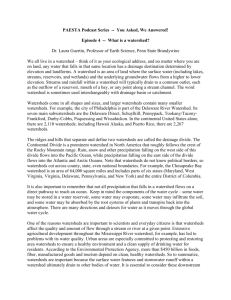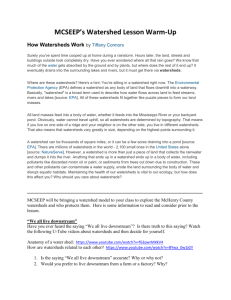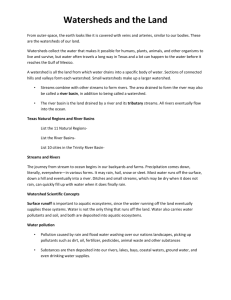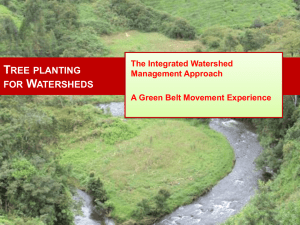INTEGRATED ASSESSMENT IN THE PHILIPPINES
advertisement
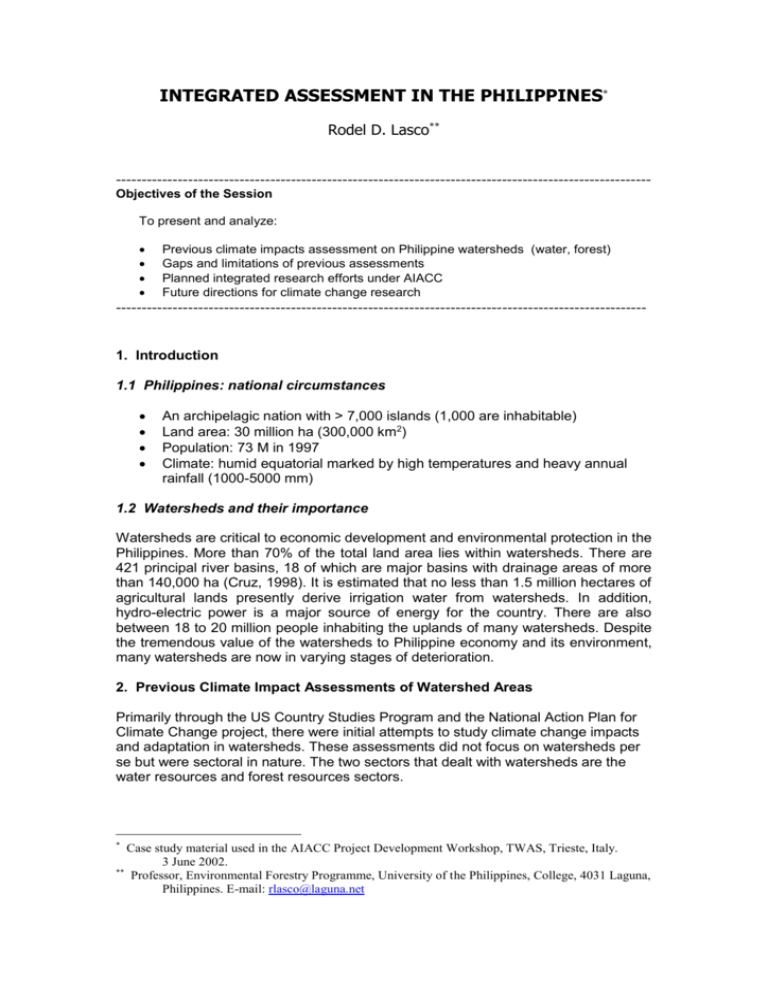
INTEGRATED ASSESSMENT IN THE PHILIPPINES* Rodel D. Lasco** -------------------------------------------------------------------------------------------------------Objectives of the Session To present and analyze: Previous climate impacts assessment on Philippine watersheds (water, forest) Gaps and limitations of previous assessments Planned integrated research efforts under AIACC Future directions for climate change research ------------------------------------------------------------------------------------------------------- 1. Introduction 1.1 Philippines: national circumstances An archipelagic nation with > 7,000 islands (1,000 are inhabitable) Land area: 30 million ha (300,000 km2) Population: 73 M in 1997 Climate: humid equatorial marked by high temperatures and heavy annual rainfall (1000-5000 mm) 1.2 Watersheds and their importance Watersheds are critical to economic development and environmental protection in the Philippines. More than 70% of the total land area lies within watersheds. There are 421 principal river basins, 18 of which are major basins with drainage areas of more than 140,000 ha (Cruz, 1998). It is estimated that no less than 1.5 million hectares of agricultural lands presently derive irrigation water from watersheds. In addition, hydro-electric power is a major source of energy for the country. There are also between 18 to 20 million people inhabiting the uplands of many watersheds. Despite the tremendous value of the watersheds to Philippine economy and its environment, many watersheds are now in varying stages of deterioration. 2. Previous Climate Impact Assessments of Watershed Areas Primarily through the US Country Studies Program and the National Action Plan for Climate Change project, there were initial attempts to study climate change impacts and adaptation in watersheds. These assessments did not focus on watersheds per se but were sectoral in nature. The two sectors that dealt with watersheds are the water resources and forest resources sectors. * Case study material used in the AIACC Project Development Workshop, TWAS, Trieste, Italy. 3 June 2002. ** Professor, Environmental Forestry Programme, University of the Philippines, College, 4031 Laguna, Philippines. E-mail: rlasco@laguna.net 2.1 Water resources sector The impacts of climate change were studied in two watersheds: Angat River and Lake Lanao (Jose et al., 1996; Cruz, 1998, 2002). Rainfall and temperature changes brought about by a 2xCO2 scenario were projected using three GCMs (CCCM, UKMO, GFDL). In addition, an incremental scenario approach was also used. Based on the change of rainfall and temperature, the amount of runoff was predicted using the WATBAL model (Yates, 1994). Angat wateshed is a strategic one in the Philippines supplying water for hydropower (average of 500 GWh per year), irrigation and domestic consumption in Metro Manila. Results of the preliminary vulnerability assessment for Angat watershed showed that changes in precipitation and temperature will result in a –15% to 32% change in runoff depending on the GCM used (Table 1). Results of incremental scenario showed that the runoff is more sensitive to changes in rainfall than in temperature (Table 2). Table 1. Changes in precipitation, temperature, and runoff for Angat water reservoir from three GCMs (based on 2xCO2) GCM Change in Precipitation Change in Temperature Change in Runoff (°C) CCCM -6% +2.0 -12% UKMO 3% +3.1 5% GFDL 15% +2.4 32% Source: Jose et al., 1996 Table 2. Percent change in Angat water reservoir runoff based on incremental changes in precipitation (P) and temperature (T) ∆P 0% ∆P 10% ∆P 20% ∆P-10% ∆P-20% ∆T 0°C 0% 8% 18% -15% -25% ∆T 2°C -1% 8% 17% -15% -26% ∆T 4°C -1% 7% 17% -16% -26% Source: Jose et al., 1996 Lake Lanao watershed is another important watershed in the southern island of Mindanao. Almost all of the GCMs projected increasing temperature and rainfall (Table 3). The CCCM and UKMO predict lower runoff while the GFDL predicts a 7% increase in runoff. Just like the Angat watershed, runoff amount is more susceptible to changes in rainfall than tempearature (Table 4) Table 3. Changes in annual precipitation, temperature and runoff for Lake Lanao from 3 GCMs (2xCO2) GCM RR Ratio Temperature Change Runoff Change (°C) (%) CCCM 0.94 2.0 -2 UKMO 1.15 2.6 -12 GFDL 1.25 2.3 7 Source: Cruz, 2002 2 Table 4. Percent change in Lake Lanao runoff based from incremental changes in precipitation (P) and temperature (T) P0 P10 P20 P-10 P-20 T0 0 -1 4 -2 -17 T2 -2 -1 3 -2 -18 T4 -1 -2 1 -3 -19 Source: Cruz, 2002 Another aspect of earlier work was the generation of adaptation strategies to address the impacts on water resources. This was done through several meetings where stakeholders were able to participate. The adaptation strategies recommended are shown in Table 5. Table 5 Supply and demand adaptation strategies for the water resources sector of the Philippines Supply Adaptation Demand Adaptation Comprehensive watershed Enhanced irrigation efficiency management Low water use crops and Water allocation system and efficient farming practices procedures Recycling (reuse) of water Improvement of monitoring and forecasting systems for floods and droughts Water pricing policies and structures Enhanced awareness of climatic change and variability Source: Cruz, 2002 2.2 Forest resources Parellel to the assessment of climate change impacts on waters resources, a similar effort was conducted for the forest sector. It should be noted that most of the forest resources of the country are in watershed areas. Thus, while there was no focus on watershed areas in previous assessments, they were partly covered by the assessments of water and forest resources. Under various GCM scenarios, tropical forest areas in the Philippines will likely expand as temperature and precipitation increase in many parts of the country (Cruz, 1997). The increase in the frequency of droughts and floods due to changes in El Niño episodes will likely render many areas unfit for agricultural crop production. Together with the growth in population and the shrinkage of arable lands, the pressure to open forestlands for cultivation could heighten. Grasslands and other areas dominated by shrub species could become more vulnerable to fire with increase in mean air temperature. This could be aggravated if these areas are subjected to prolong dry periods which is likely under an altered El Niño pattern. Frequent fires will make these already marginal lands more difficult to rehabilitate. Temperature change may lead to a loss of a few species of plants and animals that may significantly erode the biodiversity of these forests. The coastal areas especially 3 mangrove forests will be at risk of being damaged by the projected increase in siltation due to the increase in soil erosion in the uplands. This is on top of the risk of being completely wiped out by sea level rise. Finally, changes in temperature and precipitation may result to the outbreak of pests and diseases. 2.3 Gaps and limitations Considering, the limited resources available then, previous assessments were understandably general in nature and scope. From a watershed perspective, one of the main limitations of previous assessments was that they were sectoral in nature. Totally lacking was a more holistic and integrated assessment of watersheds. Specifically, there was hardly any attention given to local communities residing in watersheds. There was also heavy reliance on expert’s judgment in the face of limited information availability. 3. AIACC Integrated Assessment Partly to address the limitations of previous efforts, the AIACC-supported study will attempt to understand the impact of climate change on the whole watershed, i.e. biophysical systems and local communities. The main approach of the study is through the use of models backed up by limited field studies and surveys. 3.1 Project objectives Assess the impacts of climate change to water resources, forest ecosystems, and social systems of the watersheds; Conduct integrated vulnerability assessment of natural and social systems in the watershed areas; Develop adaptation strategies for natural water resources, forests ecosystems and social systems; Promote stakeholder participation in the research process; Contribute to peer reviewed literature; and Help build capacity of local scientists to conduct integrated assessment studies. 3.2 Project design The AIACC project originated from an earlier project supported by the Asia-Pacific Network (APN) headed by Dr. Josep Canadell of GCTE. It was designed by the principal investigator in partnership with the study team and institutions below. Philippines: University of the Philippines at Los Baños (UPLB) Department of Environment and Natural Resources (DENR) Prof. Dr. Rodel D. Lasco Prof. Dr. Rex Victor O. Cruz Dr. Juan M. Pulhin Atty. Marius Bartolabac Indonesia: Institute Pertanian Bogor (IPB) Dr. Rizaldi Boer Dr. Ekawati S. Wahyuni Ir. Key Partners Dr. Meine van Noordwijk 4 International Center for Research in Agroforestry (ICRAF), Bogor, Indonesia Dr. Josep Canadell GCTE, Australia Scientists from Vietnam, Laos and Cambodia National government agencies, NGOs and people’s organizations The main clients of the project are those with interest in climate change impacts and adaptation, including: scientists, policy-makers (DENR, DFA, DA), NGOs and students in the SE Asian region. 3.3 Methods The study will focus on a watershed each in the Philippines (Pantabangan watershed) and Indonesia (Tulang Bawang Watershed). The research framework is shown in Fig. 1. Stakeholders will be involved at various steps of the research process through workshops, meetings and consultations. Local communities will also be able to participate in impact assessment and adaptation planning. 1. Prediction of landuse and cover change resulting from climate change scenarios MAGIC-SCENGEN will be used to develop climate change scenarios. MAGICC (Model for the Assessment of GHG Induced Climate Change) uses a series of reduced-form models to emulate the behavior of fully three dimensional, dynamic GCMs. SCENGEN (Scenario Generator) is a simple database that contains the results of a large number of GCMs experiments. It manipulates data sets based on the information about the rate and magnitude of global warming supplied by MAGICC. Change of land use pattern in the future will be evaluated using the CLUE (Conversion of Land Use and its Effects) model developed by Peter Veralg at Wagenignen University. 2. Climate change impact assessment The impacts of climate change on the bio-physical and local communities will be assessed through the use of various models such as CO2-Fix for forest carbon and VIC for water resources. It is envisioned that all of the models will spatially integrated through GIS. 3. Assessment of adaptation strategies Defining objectives: For the selected watersheds these will likely include: reduction of watershed vulnerability and promotion of sustainable development. Identification of climate impacts of importance: This will be the taken from the results of the previous activity (impact assessment). Identifying the adaptation options: This will involve compiling the list of possible adaptive responses to the impacts of climate change to the selected watersheds. Aside from literature review, consultations with other experts and stakeholders will be conducted. 5 Examination of constraints: The constraints for each identified option will be analyzed using literature review and consultations with stakeholders. Quantifying the effect of adaptation measure: It will be determined whether the adaptation measure is able to help meet the stated objectives. Simulation models could be used to quantify effects on water resources. Weighing objectives and evaluating tradeoffs: The relative preference for each objective will be determined. Then the effectiveness of the various strategies to meet these objectives will be analyzed. Finally, the preferred strategies will be selected through the evaluation of tradeoffs analysis. Recommending adaptation measures: The set of recommendations will be packaged in a form that is easily understood by policy makers. 4. Vulnerability assessment The study will assess the ability of natural and social systems in the watershed areas to cope with climate change. The analysis will be carried out using analog and modeling approaches. Consistent with the APF, this will involve a two-stage process: (a) assessment of present vulnerability and (b) assessment of future vulnerability. 5. Integrated assessment The study will seek to integrate vertically (science-policy) and horizontally (across disciplines) through the use of modeling exercises and non-modeling approaches (UNEP/IES, 1996). Multi-stakeholder workshops will also be used as a tool in capturing the views of the various sectors of society including watershed communities. 3.4 Outcomes The results of the study will be extremely useful to national policy makers as well as watershed planners in Southeast Asian countries. The data generated will provide a firmer foundation in the formulation of policies that will minimize the disruptive impacts of climate change to water and forest resources. In addition, adaptation strategies will be put in place that will enable local communities in watershed areas to adapt to climate change. 6 CONCEPTUAL FRAMEWORK OF THE AIACC STUDY (AS 21) Climate change scenario Forest/carbon budget Local communities Water Budget Land use and land cover change THE WATERSHED SYSTEM Socio-economic political factors Biophysical factors 7 Table 1 Schedule of activities Year 1 Year 2 Year 3 Person (s) Responsible ACTIVITY 1. Kick-off meeting 2. Research implementation (a) Development of climate scenarios (b) Prediction of land use/cover change (c) Impact assessment (d) Formulation of adaptation strategies (e) Vulnerability assessment 3. Training for Indo-China scientists 4. Science-policy workshop 5. Report writing/journal paper writing 6. Research team meeting (mid-term and final) TriestePresentation\rdl Q1 Q2 Q3 Q4 Q1 Q2 Q3 Q4 Q1 Q2 Q3 Q4 Lead: R.D. Lasco Research team Lead: R. Boer Research team Research team Research team Research team Research team Research team Scientists from Indo-China Research team Policy makers Lead: R.D. Lasco/R. Boer Research team Research team




